Airfix 1/48 Seafire XV (conversion)
|
KIT #: |
See notes: |
|
PRICE: |
about £38.00 total |
|
DECALS: |
Several options |
|
REVIEWER: |
Frank Reynolds |
|
NOTES: |
Combination of Airfix A05117,
Spitfire XII and A06102,
Seafire XVII |
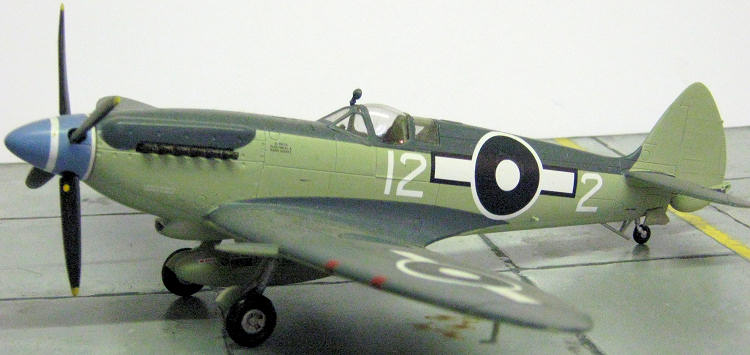
The
Seafire XV is a part of a small specialised branch of The Spitfire/Seafire
family tree, one of only three versions that are characterised by having a
short-nosed Griffon engine. The XV emerged as a navalised development of the
Spitfire XII, itself essentially a Spitfire V adapted for a Griffon engine.
Compared with earlier, sleeker Merlin engined Spitfires the short nose Griffon
types have the very obvious upper bulges around the nose to accommodate the
cylinder banks of the mighty Griffon engine. The third version, the Seafire
XVII, was a modernised version of the XV, with a strengthened undercarriage and
a cut down rear
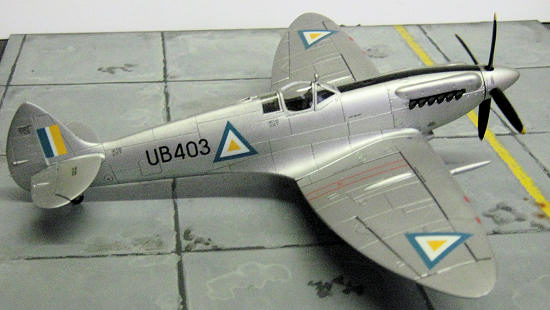 fuselage with bubble canopy. All three also feature a 4 blade
propeller and a large spinner. The XV was the first Seafire variant to feature
two symmetrical under wing fairings for the radiators and oil cooler.
Chronologically, it could have been the Seafire IV, but a change of
policy in service designations led to the Seafires being integrated into
the Spitfire numbering series.
fuselage with bubble canopy. All three also feature a 4 blade
propeller and a large spinner. The XV was the first Seafire variant to feature
two symmetrical under wing fairings for the radiators and oil cooler.
Chronologically, it could have been the Seafire IV, but a change of
policy in service designations led to the Seafires being integrated into
the Spitfire numbering series.
There
are two distinct variants of the Seafire XV, although there was no change of
service designation to identify the differences, in that early versions featured
an A-frame arrestor hook that dropped down from
a fairing in the lower rear fuselage forward of the tail wheel. This
version employed the smaller type of rudder as fitted to the Spitfire XII and a
handful of this variant featured an enlarged rudder trim tab -
this small variation is found on some French Aeronavale aircraft and
Canadian Navy versions. The second variant has a sting-type arrestor hook built
into a much larger rudder and this is a straight lift from the Mark XVII. A
feature to this sub-variant is an external triangular framework forward of the
tail wheel to prevent the arrestor cable from fouling.
A
third option is a unique hybrid Seafire XV, one of a small batch that was
refurbished for export to
Burma.
Wholly land based, all naval equipment was removed and Spitfire 18 wings were
fitted, so this variant has the appearance of a Spitfire XII, yet with twin
under wing radiators. This hybrid also had provision for under wing and centre
line bomb racks.
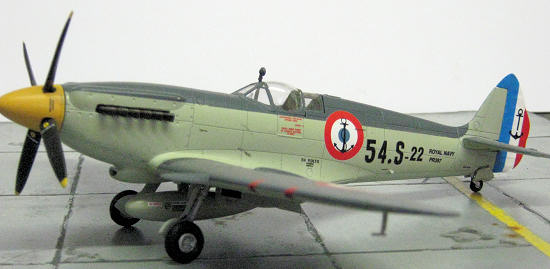 In 2011,
Airfix released new tool kits of both the Spitfire XII and Seafire XVII, each
kit having been separately reviewed in MM. The Spitfire XII by Tom Cleaver in
March 2011 and the Seafire XVII by Scott Van Aken in September 2011 A comparison
of the two kits shows that each has been separately tooled and the parts frames
are markedly different kit to kit, but thanks to the miracle of 21st
century CAD tooling, many parts are interchangeable from one to the other. The
result is that modelling a Seafire XV is a realistic proposition; just build a
Seafire XVII and where the instructions call out the fuselage assembly, use the
basic parts from the Spitfire XII. There is some modification to do, but it is
very minor. This is one all plastic conversion that requires little more than
mixing and matching parts from the two boxes. The only possible downside is that
the unused Seafire XVII fuselage is unique to that variant and so is of limited
use in the spares box.
In 2011,
Airfix released new tool kits of both the Spitfire XII and Seafire XVII, each
kit having been separately reviewed in MM. The Spitfire XII by Tom Cleaver in
March 2011 and the Seafire XVII by Scott Van Aken in September 2011 A comparison
of the two kits shows that each has been separately tooled and the parts frames
are markedly different kit to kit, but thanks to the miracle of 21st
century CAD tooling, many parts are interchangeable from one to the other. The
result is that modelling a Seafire XV is a realistic proposition; just build a
Seafire XVII and where the instructions call out the fuselage assembly, use the
basic parts from the Spitfire XII. There is some modification to do, but it is
very minor. This is one all plastic conversion that requires little more than
mixing and matching parts from the two boxes. The only possible downside is that
the unused Seafire XVII fuselage is unique to that variant and so is of limited
use in the spares box.
The Mk
XII fuselage can be assembled complete with its interior and requires the
retractable tail wheel option. Small holes are required in the lower rear
fuselage sides for the insertion of the catapult spools provided on the Mk XVII
kit, this is a simple matter of using a mini drill and copying the position from
the Mk XVII fuselage mouldings. There is a small hole to be plugged on the
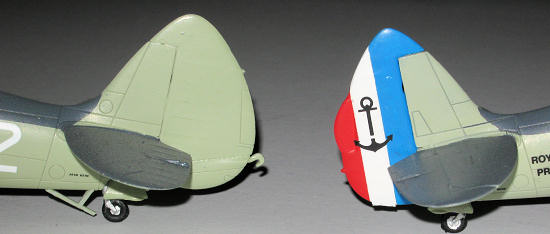 centre line of the nose between the cylinder head bulges, since the XV does not
have the small acorn shaped fairing the features on the XII.
centre line of the nose between the cylinder head bulges, since the XV does not
have the small acorn shaped fairing the features on the XII.
If
the early A-frame arrestor hook is chosen, the rear fuselage underside needs to
be modified by scribing the outline of the hinged frame and adding the beak of
the arrestor hook. Alternatively, if the sting hook option is chosen, three
small dimples should be marked out forward of the tail wheel for the wire
deflector again using the Mk XVII fuselage mouldings as a pattern.
The
wing assembly is exactly as the standard
XVII kit, to include the undercarriage and pair of radiator housings,
while the centre line drop tank is
available as a useful option.
If required, the early version rudder
can be modified to the extended trim tab by simply cutting away the existing tab
and substituting a small rectangle of plastic card, trimmed to allow for the
tapered thickness of the rudder.
The XVII
decal sheet and instructions provide a useful source of stencils and walkways. My
Royal Navy Pacific Fleet version, with sting-type arrester hook, features
Aeromaster decals as described below. It features the early post war colour
scheme of Sky undersides extending to the fuselage sides and fin/rudder with
upper surfaces of Extra Dark Sea Grey
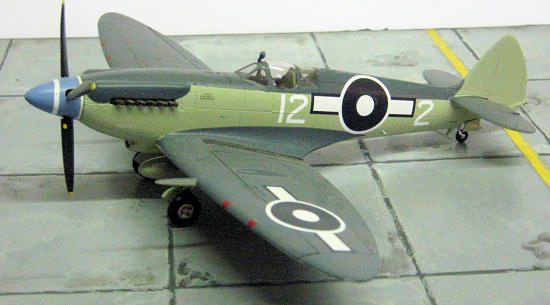 The
French Aeronavale version, with A-frame hook and enlarged rudder tab,
comes from the Carpena/Colorado sheet
listed below and again features the Royal Navy style of finish in Sky and Extra
Dark Sea Grey.
The
French Aeronavale version, with A-frame hook and enlarged rudder tab,
comes from the Carpena/Colorado sheet
listed below and again features the Royal Navy style of finish in Sky and Extra
Dark Sea Grey.
The
Burmese aircraft is overall aluminium silver with black anti-glare panels and
walkways; the national markings came from a Carpena/Colorado sheet no 48.84
(
intended for a Spitfire IX) and the
serial numbers from a generic sheet.
Paints
come from the Xtracrylix range.
For what
is essentially a minority series of aircraft the Seafires XV and XVII are quite
well served with after market decal sheets. Good
quality decals featuring the Mk.XV are
available as follows:
Aeromaster
48-697; includes two Mk.XVs: 12*2 of 806 Sqn, Royal Navy, HMS Glory 1946 and
PR464 Q Royal Canadian Navy, HMCS Warrior 1947.
Carpena/Colorado
decals sheet 48.83 features PR397 54.S-22 of Frances Aeronavale on the
carrier Arromanches 1950
Model
Alliance MA-481118, includes three Mk.XVs: SW912, 134/T,804 Sqn., Royal Navy,
HMS Theseus, 1947; PR479 L, 803 Sqn., Royal Canadian Navy, HMCS
Warrior 1947; SR530, AA*K, 883 Sqn, Royal Canadian Navy, RCNAS
Dartmouth 1948.
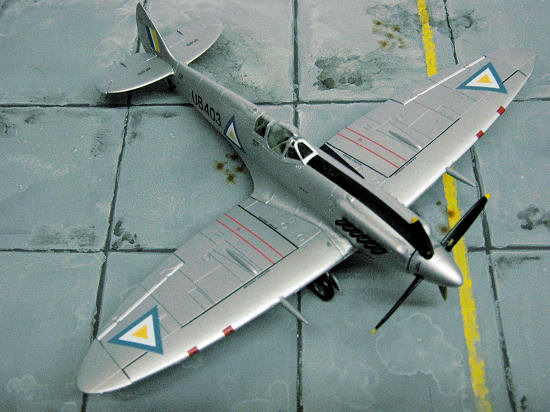 This is
quite the most logical and straightforward cross-kitting exercise that I have
come across in years. If there is any down side it is the fact that it is not
cheap, since the price of two kits and a decal sheet can push the cost past
£45-00 at UK prices; although this runs out at the price of a good resin kit,
yet this all-plastic exercise is much easier to complete. It yields a large haul
of material for the spares box and it fills a gap in a collection. It works for
me.
This is
quite the most logical and straightforward cross-kitting exercise that I have
come across in years. If there is any down side it is the fact that it is not
cheap, since the price of two kits and a decal sheet can push the cost past
£45-00 at UK prices; although this runs out at the price of a good resin kit,
yet this all-plastic exercise is much easier to complete. It yields a large haul
of material for the spares box and it fills a gap in a collection. It works for
me.
Spitfire
International by Helmut Terbeck, Harry van der Meer and Ray Sturtivant, Air
Britain (Historians) Ltd 2002.
Spitfire, the History by Eric B. Morgan and Edward Shacklady, Key Publishing,
2000
Profiles
5, Supermarine Seafire Mk.1b Mk.47, by Jon Freeman. The Aviation Workshop
Publications Ltd.
Frank Reynolds
March 2012
If you would like your product reviewed fairly and fairly quickly, please contact the editor or see other details in the
Note to
Contributors.
Back to the Main Page
Back to the Review
Index Page
fuselage with bubble canopy. All three also feature a 4 blade
propeller and a large spinner. The XV was the first Seafire variant to feature
two symmetrical under wing fairings for the radiators and oil cooler.
Chronologically, it could have been the Seafire IV, but a change of
policy in service designations led to the Seafires being integrated into
the Spitfire numbering series.
centre line of the nose between the cylinder head bulges, since the XV does not
have the small acorn shaped fairing the features on the XII.
This is
quite the most logical and straightforward cross-kitting exercise that I have
come across in years. If there is any down side it is the fact that it is not
cheap, since the price of two kits and a decal sheet can push the cost past
£45-00 at UK prices; although this runs out at the price of a good resin kit,
yet this all-plastic exercise is much easier to complete. It yields a large haul
of material for the spares box and it fills a gap in a collection. It works for
me.